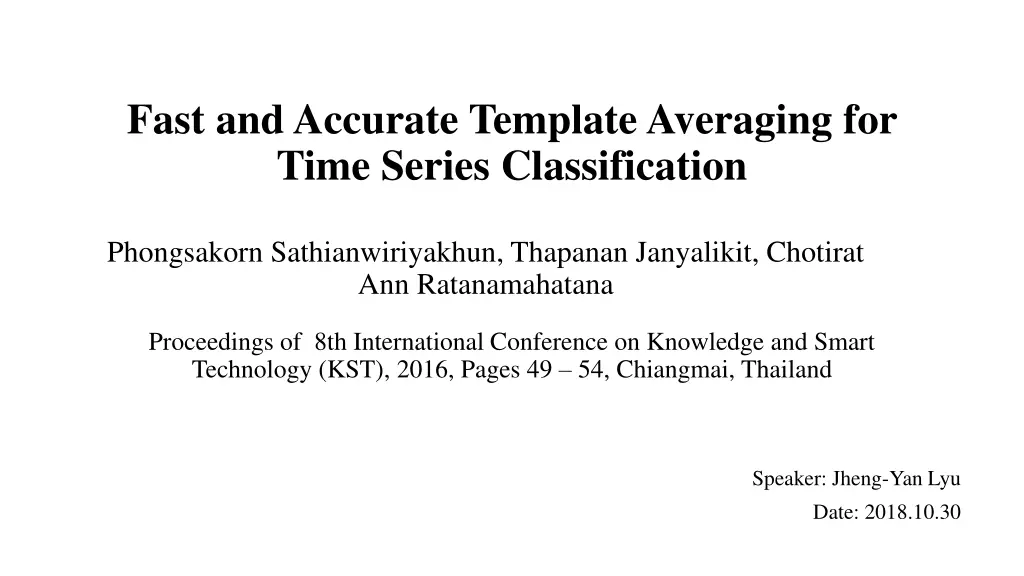
Template Averaging for Time Series Classification
"Discover how template averaging can enhance time series classification by reducing computational cost while maintaining high accuracy. Learn about a novel method proposed for efficient data condensation and boosting classification accuracies in large datasets."
Download Presentation

Please find below an Image/Link to download the presentation.
The content on the website is provided AS IS for your information and personal use only. It may not be sold, licensed, or shared on other websites without obtaining consent from the author. If you encounter any issues during the download, it is possible that the publisher has removed the file from their server.
You are allowed to download the files provided on this website for personal or commercial use, subject to the condition that they are used lawfully. All files are the property of their respective owners.
The content on the website is provided AS IS for your information and personal use only. It may not be sold, licensed, or shared on other websites without obtaining consent from the author.
E N D
Presentation Transcript
Fast and Accurate Template Averaging for Time Series Classification Phongsakorn Sathianwiriyakhun, Thapanan Janyalikit, Chotirat Ann Ratanamahatana Proceedings of 8th International Conference on Knowledge and Smart Technology (KST), 2016, Pages 49 54, Chiangmai, Thailand Speaker: Jheng-Yan Lyu Date: 2018.10.30
Abstract (1/3) Time series data are evidently ubiquitous, as we could see them in all kinds of domains and applications. As a result, various data mining tasks are often performed to discover useful knowledge, including commonly performed tasks like time series classification and clustering. Dynamic Time Warping (DTW) is accepted as one of the best available similarity measures, which has been used for distance calculation in both classification and clustering algorithms. However, its known drawback is its exceedingly high computational cost. Recently, data condensation method through template averaging is applied; 2
Abstract (2/3) each class of data can be represented by one template which could greatly speed up the classification with DTW especially in large datasets, with the trade off in lower classification accuracies. Subsequently, various attempts have been made to increase the number of representative templates to boost up the accuracies while keeping the computation complexity not too high. However, those algorithms still suffer from many predefined and hard-to-set parameters, while some require high computation time for high accuracy results. Therefore, in this work, we propose an accurate yet simple template averaging method that is parameter free and has 3 much less computation time.
Abstract (3/3) The experiment results on 20 UCR time series benchmark datasets demonstrate that our proposed method can achieve a few orders of magnitude speedup while maintaining high classification accuracies. 4
Find initial pivoting sequence for each class T is a set of k time series sequences of the same class with the length l 5
Subclass splitting Calculate Euclidean distance between the pivot sequence and all other data sequences within the class. Sort these distance values, and then compute adjacent discrepancies of the values. Then the standard deviation value of these adjacent discrepancies will be used as a threshold to split data into subclasses. Separate the data into subclasses by splitting at the sequence that has difference larger than half of the computed standard deviation. 6
Subclass splitting The main reason why we use Euclidean distance instead of DTW in this step is much faster to compute Euclidean distance can better illustrate the differences between the two sequences than DTW could. As demonstrated in Fig.2 7
Different Pivots and Nearest-Neighbor Points sequences 1, 2 and 3 are of class 1 and sequences 4 and 5 are of class 2. 8
Dynamic time warping Barycenter Averaging(DBA) DBA is the most recently proposed time series averaging method for DTW DBA simultaneously averages all of the sequences together. DBA consists of two important steps: 1. Compute DTW distances between the selected pivot sequence and other sequences to obtain the warping paths that will be used to align all of the sequences. 2. Once the warping paths are obtained, they are used to align all of the sequences and calculate the average sequence, and this new averaged sequence will be a new pivot in the next iteration. 9
